
Marais des Bouligons
Following the massive rock slide at "Le Claps" in 1442, the River Drôme was blocked and one big lake formed. Drained in the 19th century, it remains only the marsh. An interpretation path enables its fascinating fauna and flora to be discovered.
The site is overhung by the ruins of Rochebrianne’s castle (viewpoint).
This marsh of 65 hectares, fed by the waters side and the stream of Bouligons, is the biggest wetland of the department. It is the last remain of the “Grand lac” created during the rockslide of the Pic de Luc in 1442.
The site is consists of a reed marsh, highly developed in its central part, and of wet meadow (organic pasture). it has a huge diversity of flora, with rare and remarkable species whose the largest extent of Epipactis des Marais (Epipactis Palustris) of the department, and many species of birds : le râle d’eau (Rallus Aquaticus), le busard cendré (Circus Pygargus), la bouscarle (Cettia Cetti) and the rousserolle effarvatte (Acrocephalus Scirpaceus)…
Dragonflies such as the rare Agrion de Mercure (Coenagrion Mercuriale), and butterflies are present, as some reptiles and batrachians, such as the grenouille rousse (Rana temporaria) or the couleuvre a collier (Natrix natrix). The site allows to wild boar and deer as a refuge. The service “Espaces Naturels Sensibles” from the Department set up one plan of management on the site, with the utilisation of ovine and equine for the pasture.
Our services
- Car park
- accepted animals
Further information
Opening
Throughout the year
Through Office de Tourisme du Pays Diois





